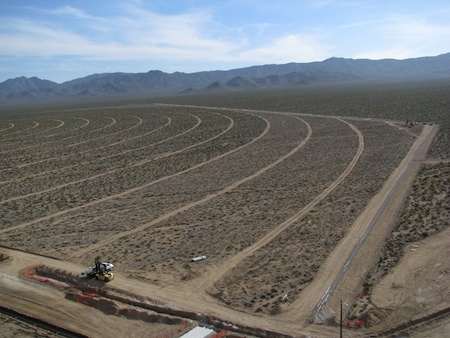Huge solar farms are an increasingly hot topic nowadays. Companies like Brightsource, Abengoa, Solar Millennium and NextEra are planning giant projects in the U.S. Abengoa has its 280-MW Solana project; Solar Trust of America, which is owned in part by Solar Millennium, has its 1,000-MW Blythe solar project (divided into four 250-MW parts); and Brightsource has its 392-MW Ivanpah project, just to name a few.
Ucilia Wang’s recent The Rise of Concentrating Solar Thermal Power explores some of these big projects in detail.
These are massive undertakings by big developers who are looking to capitalize on economies of scale, using varying forms of concentrating solar power (CSP) technology. Many are also the recipients of government money to pursue the projects.

In the past, CSP has been criticized for the amount of water that power plants need in order to run as well as the displacement of rare plants and wildlife, such as the desert tortoise, that takes place when projects get built. Now it faces another onslaught of critics: those who believe that the only way the U.S. should pursue solar power is through small-scale distributed PV.
Organizations against the use of “big solar” have cropped up in a few places. Janine Blaeloch, co-founder of Solar Done Right, an organization that takes particular issue with putting large-scale solar on public lands, wrote an op-ed for RenewableEnergyWorld.com that refuted four beliefs about large-scale solar power development. First, she said the idea that we need big solar in order to meet our RPS goals is simply not true. “Even with its small size and low solar insolation, Germany installed about 3,000 MW of mostly decentralized PV in 2009 alone — and in 2010, about 6,500 MW of distributed PV,” she pointed out. Blaeloch also takes aim at the idea that large-scale projects are cheaper than distributed PV. She said, “a Los Angeles cooperative called Open Neighborhoods announced a residential PV cooperative solar buy for $4.78 per watt, almost identical to the price for industrial-scale installations.”
Blaeloch thinks that large-scale projects will not help meet climate change goals faster. She said that the large-scale projects that have been proposed will face legal challenges going far into the future and believes that in the end it’s the big projects that will take longer to develop than proven, distributed PV.
Lastly, distributed PV also won’t need the giant transmission build-out that will be required to move power from many of the remote CSP project locations – another cost savings.
Isn’t Bigger Always Better?
On the other hand, let’s remember that we are talking about development in America – the land of the big and beautiful. We celebrate big things in this country.
Building large, centralized power plants is the way we know how to make power. It’s easy for a combined cycle power plant developer like Abengoa to make the switch to CSP because in essence the overall development format is the same, even though the technology may be very different.
Big solar also means big profits for developers and the EPC companies they choose as partners, like Bechtel. Bechtel is the construction company for Ivanpah. It has 52,700 employees and in 2010 booked revenue of $27.9 billion, according to the company’s website. Let’s face it, big business — like Bechtel — has a lot of influence in American markets and politics. In order to advance the solar industry, doesn’t it make sense to have big business behind it?
If Bechtel sees solar power as a viable, profitable industry, won’t that bode well for the growth of solar in general? Daily RenewableEnergyWorld.com blogger Dana Blankenhorn put it this way: “It’s not a question right now of big solar or small solar, big wind or small wind. It’s a question of energy harvesting or caveman energy, energy collected from the abundance all around us or materials ripped from the ground and burnt. Until that choice is made, arguing over the environmental impact of any renewable project strikes me as energy misspent.”
Rhone Resch, President and CEO of the Solar Energy Industries Association (SEIA) agrees with Blankenhorn. He testified in June at a Congressional hearing that was intended to identify roadblocks to solar development on public lands. Resch argued, “like most products, solar energy’s costs decrease as more and more solar is installed.”
When an industry is just getting up to speed, as solar is, I’m not sure it makes sense to put up roadblocks to stifle its development. Once we know what we’re doing, maybe then we should go in and start making restrictions about where and how large farms should ideally be.
 Follow
Follow